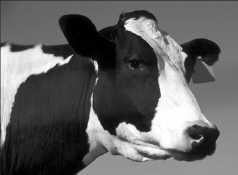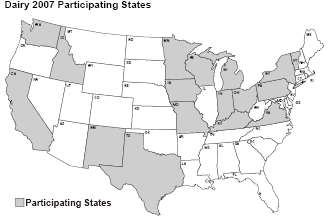



National Animal Health Monitoring System to Study Dairy Industry 2007
US - The USDA's NAHMS conducts national studies on the health and management of America’s livestock, poultry, and aquaculture populations. These studies are designed to meet the information needs of the industries and other stakeholders—as identified by people working with these industries.
In 1991, NAHMS conducted the Dairy Heifer Evaluation Project (DHEP). The DHEP provided baseline information on heifer health and management practices, as well as prevalence estimates for Cryptosporidium, Escherichia coli 0157:H7, and Salmonella.
The Dairy ’96 study built on the results of the DHEP. Objectives of the Dairy ’96 study included acquiring national prevalence estimates of Mycobacterium paratuberculosis (Johne’s disease) and infections of bovine leukosis virus; and fecal shedding of E. coli 0157 and Salmonella in adult dairy cows.
A major focus of the Dairy 2002 study was to describe management strategies that prevent and reduce Johne’s disease and to determine management factors associated with Mycoplasma and Listeria in bulk tank milk. Additionally, levels of participation in quality assurance programs, the incidence of digital dermatitis, a profile of animal waste handling systems used on U.S. dairy operations, and industry changes since the DHEP in 1991 and Dairy ‘96 were examined.
Dairy 2007 Study
The Dairy 2007 study will continue to address the priority issues of the U.S. dairy industry and other stakeholders. Seventeen States will participate in the Dairy 2007 study (see map). These States represent 79.3 percent of U.S. dairy herds and 82.0 percent of U.S. dairy cows.
The Dairy 2007 study will
• Describe trends in dairy cattle health and management practices,
• Evaluate management factors related to cow comfort and removal rates,
• Describe dairy calf health and nutrition from birth to weaning and evaluate heifer disease prevention practices,
• Estimate the prevalence of herds infected with bovine viral diarrhea virus (BVD),
• Describe current milking procedures and estimate the prevalence of contagious mastitis pathogens,
• Estimate the herd-level prevalence and associated costs of Mycobacterium paratuberculosis,
• Describe current biosecurity practices and determine producer motivation for implementing or not implementing biosecurity practices, and
• Determine the prevalence of specific food safety pathogens and describe antimicrobial resistance patterns.
 By gathering reliable and valuable information on the U.S. dairy industry, the Dairy 2007 study will help to:
By gathering reliable and valuable information on the U.S. dairy industry, the Dairy 2007 study will help to:
• Define and evaluate current management practices and trends in the U.S. dairy industry,
• Help policymakers and industry make
informed decisions,
• Assist researchers and private enterprise to identify and focus on vital issues related to dairy cattle health and productivity, and
• Conduct economic analyses of the health and production of the U.S. dairy industry.
Participation in all NAHMS studies is voluntary. Randomly selected producers will be contacted by representatives from USDA’s National Agricultural Statistics Service between January 1 and January 31, 2007. An on-site questionnaire will be administered, and eligible producers will be asked to participate in the second phase of the study. Producers that choose to continue in the study will be visited by veterinary medical officers (VMOs) and/or animal health technicians (AHTs) who will administer questionnaires and take biological/environmental samples between February 26 and April 30, 2007. At the producers’ option, VMOs and/or AHTs may make a second visit to some operations between May 1 and July 31, 2007.
Testing Options
Biological/environmental sample test results will be provided to participating producers at the conclusion of the study.
• Evaluation of passive transfer Goal: Estimate the percentage of calves that receive adequate immunoglobulins through colostrum by measuring serum proteins in calves 1 to 3 days of age.
• BVD Goal: Estimate the herd-level prevalence of BVD in herds with persistently infected animals.
• Johne's disease Goal: Estimate the herd-level prevalence of Mycobacterium paratuberculosis. Six composite environmental samples will be collected from each participating herd.
• Mastitis Pathogens Goal: Estimate the herd-level prevalence of contagious mastitis pathogens
(Streptococcus agalactiae, Staphylococcus aureus, and Mycoplasma). Bulk-tank milk samples will be collected from each participating herd.
• Food Safety Pathogens Goal: Estimate the prevalence of specific food safety pathogens such as Salmonella and Campylobacter via testing of fecal samples.
Confidentiality
Because NAHMS’ studies rely on voluntary participation, the privacy of every participant is protected. Only the data-collector knows the identity of the respondent. No name or address is ever recorded in any database. No data will be reported on any individual or in a manner that would allow the identification of an individual.
TheCattleSite news desk


